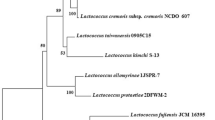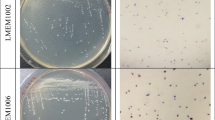Abstract
An attempt was made, to characterize natural antibiotics or lantibiotics from unconventional sources and its antibacterial spectrum against food borne pathogens and drug resistant bacteria. Six different traditional fermented foods i.e., fermented fish, fermented soybeans, Soibum (fermented bamboo shoots), milk, idly and dosa batter were used for the isolation of bacteriocin producing Lactic acid bacteria (LAB). Among all bacterial cultures isolated from the various sources, 129 cultures have found to produce antimicrobial compounds. Nisin specific reporter bacteria was utilized as biosensor to identify the Nisin like bacteriocin, where 10 cultures found to be positive Nisin producer. Identified Nisin like bacteriocin was partially concentrated by using ammonium sulphate followed by butanol extraction. Minimum inhibitory concentration (MIC) was analyzed against food borne pathogen and drug resistant bacteria. MIC of partially purified Nisin (pp-Nisin) of all the LAB isolates against food-borne pathogens are ranged between 0.5 and 92 µg/ml respected to various Gram-positive bacteria. Similarly, the drug resistant bacteria were also inhibited by pp-Nisin (MIC ranged between 15 and 175 µg/ml). All samples of ppnisin exhibited auto induction ability. Taxonomic identification of the nisin producers was done by whole genome sequencing which reveals that cultures belongs to Lactococcus lactis ssp. lactis. Also it was found that Lactococcus lactis ssp. lactis C2d and Lactococcus lactis ssp. lactis SP2C4 harbor nisA gene and Lactococcus lactis ssp. lactis FS2 (L. lactis FS2) harbor nisQ gene. The finding of this study highlights the first case of L. lactis FS2 isolated from fermented fish harbor nisQ gene. Antibacterial activity of pp-Nisin against drug resistant LAB is also reported.



Similar content being viewed by others
References
Jack RW, Jung G (2000) Lantibiotics and microcins: polypeptides with unusual chemical diversity. Curr Opin Chem Biol 4(3):310–317
de Arauz LJ, Jozala AF, Mazzola PG, Penna TCV (2009) Nisin biotechnological production and application: a review. Trends Food Sci Tech 20(3–4):146–154
Prince A, Sandhu P, Ror P, Dash E, Sharma S, Arakha M, Jha S, Akhter Y, Saleem M (2016) Lipid-II independent antimicrobial mechanism of nisin depends on its crowding and degree of oligomerization. Sci Rep 6(1):1–15
Osullivan L, Ross RP, Hill C (2002) Potential of bacteriocin-producing lactic acid bacteria for improvements in food safety and quality. Biochimie 84(5–6):593–604
Manyi-Loh C, Mamphweli S, Meyer E, Okoh A (2018) Antibiotic use in agriculture and its consequential resistance in environmental sources: potential public health implications. Molecules 23(4):795
Marshall SH, Arenas G (2003) Antimicrobial peptides: A natural alternative to chemical antibiotics and a potential for applied biotechnology. Electron J Biotechn 6(3):271–284
Perez RH, Zendo T, Sonomoto K (2014) Novel bacteriocins from lactic acid bacteria (LAB): various structures and applications. Microb Cell Fact 13(1):3
Lázár V, Martins A, Spohn R, Daruka L, Grézal G, Fekete G, Számel M, Jangir PK, Kintses B, Csörgő B, Nyerges Á (2018) Antibiotic-resistant bacteria show widespread collateral sensitivity to antimicrobial peptides. Nat Microbiol 3(6):718–731
O’Connor PM, O’Shea EF, Guinane CM, O’Sullivan O, Cotter PD, Ross RP, Hill C (2015) Nisin H is a new nisin variant produced by the gut-derived strain Streptococcus hyointestinalis DPC6484. Appl Environ Microbiol 81(12):3953–3960
Ayukekbong JA, Ntemgwa M, Atabe AN (2017) The threat of antimicrobial resistance in developing countries: causes and control strategies. Antimicrob Resist In 6(1):47
Zendo T, Fukao M, Ueda K, Higuchi T, Nakayama J, Sonomoto K (2003) Identification of the lantibiotics nisin Q, a new natural nisin variant produced by Lactococcus lactis 61–14 isolated from a river in Japan. Biosci Biotechnol Biochem 67(7):1616–1619
Nithya V, Halami PM (2019) Characterization and mode of action of a potent bio-preservative from food-grade Bacillus licheniformis MCC 2016. Prep Biochem Biotechno 49(4):334–343
Burkard M, Entian KD, Stein T (2007) Development and application of a microtiter plate-based autoinduction bioassay for detection of the lantibiotic subtilin. J Microbiol Methods 70(1):179–185
Garvie EI (1986) Request for an opinion: conservation of the name Pediococcus acidilactici with DSM 20284 as the neotype strain and rejection of the previous neotype strain NCDO 1859 (= IFO 3884= DSM 20333= ATCC 33314). Int J Syst Evol Micr 36(4):579–580
Devi SM, Halami PM (2011) Detection and characterization of pediocin PA-1/AcH like bacteriocin producing lactic acid bacteria. Curr Microbiol 63(2):181–185
Shobharani P, Padmaja RJ, Halami PM (2015) Diversity in the antibacterial potential of probiotic cultures Bacillus licheniformis MCC 2514 and Bacillus licheniformis MCC2512. Res Microbiol 166(6):546–554
Halami PM (2019) Sublichenin, a new subtilin-like lantibiotics of probiotic bacterium Bacillus licheniformis MCC 2512T with antibacterial activity. Microb Pathog 128:139–146
Thompson JD, Higgins DG, Gibson TJ (1994) CLUSTAL W: improving the sensitivity of progressive multiple sequence alignment through sequence weighting, position-specific gap penalties and weight matrix choice. Nucleic Acids Res 22(22):4673–4680
Spieß T, Korn SM, Kötter P, Entian KD (2015) Auto-induction specificities of the lantibiotics subtilin and nisin. Appl Environ Microbiol 81(22):7914–7923
De Pascale G, Grigoriadou C, Losi D, Ciciliato I, Sosio M, Donadio S (2007) Validation for high throughput screening of a VanRS based reporter gene assay for bacterial cell wall inhibitors. J Appl Microbiol 103(1):133–140
Biswas SR, Ray P, Johnson MC, Ray B (1991) Influence of growth conditions on the production of a bacteriocin, pediocin AcH, by Pediococcus acidilactici H. Appl Environ Microbiol 57(4):1265–1267
Cheigh CI, Choi HJ, Park H, Kim SB, Kook MC, Kim TS, Hwang JK, Pyun YR (2002) Influence of growth conditions on the production of a nisin-like bacteriocin by Lactococcus lactis subsp. lactis A164 isolated from kimchi. J Biotechnol 95(3):225–235
Vogelmann SA, Seitter M, Singer U, Brandt MJ, Hertel C (2009) Adaptability of lactic acid bacteria and yeasts to sourdoughs prepared from cereals, pseudocereals and cassava and use of competitive strains as starters. Int J Food Microbiol 130(3):205–212
Yang R, Ray B (1994) Factors influencing production of bacteriocins by lactic acid bacteria. Food Microbiol 11(4):281–291
Zhou H, Fang J, Tian Y, Lu XY (2014) Mechanisms of nisin resistance in Gram-positive bacteria. Ann Microbiol 64(2):413–420
Fuchs SW, Jaskolla TW, Bochmann S, Kötter P, Wichelhaus T, Karas M, Stein T, Entian KD (2011) Entianin, a novel subtilin-like lantibiotic from Bacillus subtilis subsp. spizizenii DSM 15029T with high antimicrobial activity. Appl Environ Microbiol 77(5):1698–1707
Cotter PD, Ross RP, Hill C (2013) Bacteriocins-a viable alternative to Antibiotics. Nat Rev Microbiol 11(2):95–105
Nithya V, Halami PM (2012) Novel whole-cell reporter assay for stress-based classification of antibacterial compounds produced by locally isolated Bacillus spp. Indian J Microbiol 52(2):180–184
Figueras MJ, Beaz-Hidalgo R, Hossain MJ, Liles MR (2014) Taxonomic affiliation of new genomes should be verified using average nucleotide identity and multilocus phylogenetic analysis. Genome Announce 2:6
Li H, O’Sullivan DJ (2006) Identification of a nisI promoter within the nisABCTIP operon that may enable establishment of nisin immunity prior to induction of the operon via signal transduction. J Bacteriol 188(24):8496–8503
Piper C, Hill C, Cotter PD, Ross RP (2011) Bioengineering of a Nisin-A producing Lactococcus lactis to create isogenic strains producing the natural variants Nisin F, Q and Z. Microb Biotechnol 4(3):375–382
Field D, Connor PM, Cotter PD, Hill C, Ross RP (2008) The generation of nisin variants with enhanced activity against specific Gram-positive pathogens. Mol Microbiol 69(1):218–230
Gao Y, Lu Y, Teng KL, Chen ML, Zheng HJ, Zhu YQ, Zhong J (2011) Complete genome sequence of Lactococcus lactis subsp. lactis CV56, a probiotic strain isolated from the vaginas of healthy women. J Bacteriol 193:2886–2887
Jaimee G, Halami PM (2016) High level aminoglycoside resistance in Enterococcus, Pediococcus and Lactobacillus species from farm animals and commercial meat products. Ann Microbiol 66(1):101–110
Tamura K, Peterson D, Peterson N, Stecher G, Nei M, Kumar S (2011) MEGA5: molecular evolutionary genetics analysis using maximum likelihood, evolutionary distance, and maximum parsimony methods. Mol Biol Evol 28(10):2731–2739
Na SI, Kim YO, Yoon SH, Ha SM, Baek I, Chun J (2018) UBCG: up-to-date bacterial core gene set and pipeline for phylogenomic tree reconstruction. J Microbiol 56(4):280–285
Acknowledgements
The authors wish to acknowledge the Director, CFTRI, Mysore for providing the facilities. This work has been carried out under Department of Biotechnology, Government of India, New Delhi funded project Twinning Research, Project No. BT/PR16706/NER/95/259/2015. The authors also like to thank Prof. Dr. JP Tamang, Sikkim University, Gangtok, India for providing support in whole genome sequencing.
Author information
Authors and Affiliations
Corresponding author
Additional information
Publisher's Note
Springer Nature remains neutral with regard to jurisdictional claims in published maps and institutional affiliations.
Supplementary Information
Below is the link to the electronic supplementary material.
Rights and permissions
About this article
Cite this article
Sharma, B.R., Jayant, D., Rajshee, K. et al. Distribution and Diversity of Nisin Producing LAB in Fermented Food. Curr Microbiol 78, 3430–3438 (2021). https://doi.org/10.1007/s00284-021-02593-8
Received:
Accepted:
Published:
Issue Date:
DOI: https://doi.org/10.1007/s00284-021-02593-8




